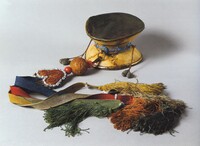
Probably one of the most famous Tibetan contemporary artists of his time was the 10th Karmapa, Choying Dorje (1604-1674). It is said that he was trained in a traditional Menri Style and then later studied in a Kashmiri style. What is obviously apparent is that the examples of his work that have come down to us today are in a unique style - the style of Choying Dorje. The three images of paintings below are by the 10th Karmapa Choying Dorje).
See other works of art by Choying Dorje.

For the multi-faced and armed deity, note the gate-like halo surrounding the main figure. It is created to appear as if water, manipulated and suspended. Also see the throne beneath the central subject, rendered with the same treatment, and added figures supporting the pink lotus.

Probably the most unique set of paintings created by Choying Dorje is the life story of Shakyamuni Buddha. No explanation should be required, all that one need to do is look to see how special it is. Look at the colours, the forms, the composition, the rendering of the human figures, animals and birds.

The 10th Karmapa was also famous for his depictions of animals and birds. Notice in this painting of a yellow goddess how the sow and piglets beneath the deity figure are rendered far more life-like with a richness of detail than the yellow deity herself.
A capital 'C' contemporary artist, although sometimes trained traditionally, is often somebody that breaks the rules and is innovative. Sometimes the artist is copied by other artists and a new style is created from that, and at other times no one can follow where that artist has gone.
Choying Dorje is an example of a contemporary artist that was not followed by other artists. It also can't really be said that he was a traditional Tibetan artist either - he was an innovative contemporary artist of his time. I believe that he had a love of art, and of animals - clearly shown in his paintings and biography - and I believe that he created art for art's sake.




 The
The 





 This Kunzang Akor is the most important Bon sculpture to appear in years. Back in 2006 a
This Kunzang Akor is the most important Bon sculpture to appear in years. Back in 2006 a 